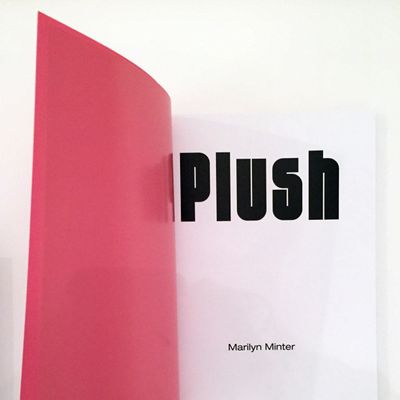
John Ruskin, as any liberal arts grad will tell you, is famous less for being the defining voice of Victorian art criticism and more for the putative story of his wedding night: He gazed upon his brideÔÇÖs naked body, saw her muff, and fled in horror. Ruskin died in 1900, but our own repulsion at and fascination with female pubic hair continues to mirror his. The human body holds myriad uncanny sites, but few are as contested or as overdetermined as the female mons. Hairy or bare, itÔÇÖs rife with meaning, intrigue, and analysis. ItÔÇÖs also the shiny, glossy, four-color subject of Marilyn MinterÔÇÖs glam new art book, Plush.
If you could epitomize the art worldÔÇÖs consensus on female pubic hair in art into a phrase you could paint on a wall, itÔÇÖd go like this: RUSKIN LIVES! Like Frodo, like Morrison, like Che, Ruskin breathes life long after his expiration date. His long arm reaches from the grave, and in his hand, he clutches a fat hank of pubic hair.
HereÔÇÖs the thing about female pubic hair: Ruskin, for all his reactionÔÇÖs ambient misogyny, kind of had a point. You look at the long history of art, and thereÔÇÖs not a lot of hairy female nethers before the mid-20th century. Egyptian art and a few Greek pieces showed neat little stylized triangles on both sexes; medieval artists gestured toward male pubes but never showed female pubes. By the Renaissance, some male figures were adorned with decorous Roman curls, though most were bare. All women were.
Prior to feminismÔÇÖs appropriation of pubes in the ÔÇÖ70s, three major moments define Western artÔÇÖs feelings about female pubic hair, and those feelings are a tangled nest of shocking, obscene, entrancing, and a little gross. Francesco GoyaÔÇÖs demure La Maja Desnuda (1797ÔÇô1800), a naked chick with a come-hither face and a tender shadow of hair between her plump thighs; Gustave CourbetÔÇÖs LÔÇÖOrigine du Monde (1866), the swainÔÇÖs-eye view of a be-furred, truncated female torso; and ModiglianiÔÇÖs 1917 show of nudes, all reclining, teeth bared, luxuriating in their natural hirsute forms. Of course other artists had painted female pubic mounds aplenty, but these works were strictly pornographic. Indeed, what was most shocking about the Goya, the Courbet, and the Modigliani was their eliding high and low art. A chickÔÇÖs pubic hair will do that to an otherwise respectable painting.
While most of art history looks askance at female pubic hair, Marilyn Minter invites you to get all up in these hairy snatches. Just as sheÔÇÖd previously done in her glossy, liquid photos of womenÔÇÖs lipstick-loved mouths, bedazzled high-heels in mud, gilded tongues, and glittered eyes, Minter simultaneously deconstructs and glamorizes her subject in Plush. These 70 photos capture the pubic triangles of several models of a variety of races, all women whom Minter paid to grow their pubes. Amassed in this book, these photos make the female bush into a decontextualized thing of glory. Like close-up shots of a luxury carÔÇÖs leather upholstery, MinterÔÇÖs photographs entice you to pet, to stroke, to feel, to rub your cheek against them ÔÇö if theyÔÇÖll let you.
Though feral and faintly menacing, thereÔÇÖs no Freudian uncanny in Plush. Which is kind of weird, actually, because Minter has arranged the photographs to pull you in, up, and to its subjects. This 9-by-12-inch book makes its pubes larger than life. TheyÔÇÖre Brobdingnagian bushes, and given scale only by the cunning placement of hands ÔÇö fingernails all long and painted acid green, milk white, Louboutin red, or Sunny-D orange ÔÇö or the occasional errant piece of lingerie, these pubic triangles loom large. Trapped by steamy shower glass, shiny with lube, bright against chainmail, these pubic hairs gleam. They glisten. They┬áskinkle.
As the camera moves closer to its subjects, the hairs turn kaleidoscopic. Standing tall and glossy, theyÔÇÖre nets, theyÔÇÖre barbed wire, theyÔÇÖre a winter wonderland. Minter brings the viewer up close and personal to a variety of pubic mounds: a flamey conflagration of firecrotch, a snowy billow of candy floss, a bristly jungle of pin-straight black filaments. The hairs seem to call, to wrap their tender tendrils about the viewer, to draw us in. Lush and delicious, these photos make you want to smell them.
ÔÇ£Fashion is fleeting. Laser is forever,ÔÇØ Minter┬álikes to remind us┬áon Twitter, but itÔÇÖs not that simple. Thumbing through Plush, seduced by these pelts and MinterÔÇÖs shiny, shiny style, itÔÇÖs easy to forget how embattled womenÔÇÖs nether regions are. The rush to Brazilian waxing during the heyday of Sex and the City, mediaÔÇÖs fretting over womenÔÇÖs decisions to remove their hair, and the inevitable backlash ÔÇö might make you think that itÔÇÖs a new thing, this will to depilation. ItÔÇÖs not, of course. Pubic hair, whether having it, shaving it, or showing it, has always been fraught with meaning.
In this post-porn, postÔÇôKaren Finley world, itÔÇÖs easy to think that a book like Plush is just another whatever-whatever token of feminist self-determination and blah-blah-blah reappropriation of female representation. But remember that this July a London gallery removed Leena McCallÔÇÖs┬áPortrait of Ms Ruby May┬ábecause it was ÔÇ£pornographicÔÇØ and ÔÇ£disgusting.ÔÇØ The crime? A shadowed landing strip of pubic hair in the subjectÔÇÖs unzipped pants.
Ruskin lives, and he doesnÔÇÖt quite know where to look. Marilyn Minter holds his head in taloned hands and makes him contemplate the infinite glory of the bush.


